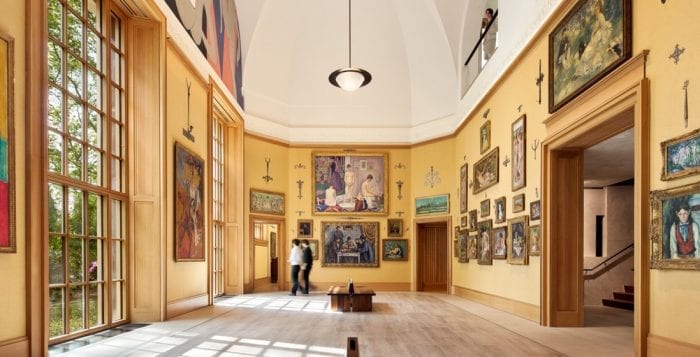Between You and Me: Philadelphia – City of Brotherly Love, Culture and History
By Leah S. Dunaief

During the recent holiday break, we took advantage of the free time to visit two delightful museums in Philadelphia: The Barnes Foundation and the Museum of the American Revolution. The Barnes is home of a huge collection of Impressionist paintings, among many other treasures, and the Museum of the American Revolution, not quite 2 years old, is dedicated to telling the story of our evolution from the historic center of America’s founding.
The Barnes started as the remarkable personal collection of Dr. Albert C. Barnes. Born in Philadelphia in 1872 into a working class family, he graduated from the University of Pennsylvania medical school and went off to Germany to study chemistry. From his work there, he made his fortune by co-inventing a silver nitrate antiseptic, called Argyrol, with a German colleague Hermann Hille.
Buying out Hille, he ran the A.C. Barnes Company from 1908-29 and in the process started to collect art. Ironically he didn’t much care for the Impressionists until his high school friend and artist, William Glackens, persuaded him otherwise. He sent Glackens off to Paris to buy some paintings, and when the artist returned with 33, Barnes became serious about collecting art and took over the purchasing himself, housing the works at his estate.
Barnes started the Barnes Foundation in 1922, a nonprofit cultural and educational institution to “promote the advancement of education and appreciation of fine arts and horticulture.” The foundation oversees the art, and since 2012 the collection has been located on Benjamin Franklin Parkway in a splendid compound that honors both the founder and the masters whose works lie within its walls and in its gardens. There is even a parking lot on the premises that makes a visit so much easier.
The Barnes boasts the world’s single largest collection of paintings by Pierre-Auguste Renoir, with 181, and ditto for those by Paul Cézanne with 69. There are also 59 by Matisse, 46 by Pablo Picasso, as well as art by Modigliani, van Gogh, Seurat and Barnes’ friend, Glackens. Also in the dazzling museum are paintings by Old Masters El Greco, Peter Paul Rubens, Titian and Veronese. There are sculptures, masks, tools, jewelry, textiles, ceramics, manuscripts and one of the most outstanding collections of wrought iron, some 887 pieces, among so many other multicultural offerings.
A major exhibition, which sadly will end there this Sunday, Jan. 12, is 30 Americans. Featuring works of many of the most important African American artists of the past four decades, according to the museum’s curator, Gwendolyn DuBois Shaw — herself a famous African American professor at the University of Pennsylvania and a top administrator at the Smithsonian — this collection “explores issues of personal and cultural identity against a backdrop of pervasive stereotyping — of race, ethnicity, gender, sexuality and class.”
The artists include Jean-Michel Basquiat, Mark Bradford, Nick Cave, Mickalene Thomas, Kehinde Wiley and Barkley Hendricks along with 24 others, and some of the paintings are riveting. This is the 10th anniversary of 30 Americans and the first in the Northeast since 2011 when it was in Washington, D.C. Chatting with other visitors, we learned that many came from some distance to catch up with this exhibit of modern artists and their distinct perspectives.
Did I mention that there is also a wonderful restaurant inside the Barnes?
This doesn’t leave me much space to tell you about the Museum of the American Revolution, more the pity, which is also handsomely housed in central Philadelphia.
Of particular interest is their first international loan exhibition, Cost of Revolution: The Life and Death of an Irish Soldier, which will remain in place until March 17. By focusing on Richard St. George, born in County Galway to Protestant landed gentry and who became a soldier, artist, writer and extensive landowner, the exhibit tells us much about the American Revolution of 1776, the Irish Rebellion of 1798 — and life in the British army, which St. George joined. There are paintings, many sketches that St. George made himself, artifacts and weaponry in a comprehensive display of history from that era.
By the way, it is really easy to get to Philadelphia from here on Long Island with only a stopover in Penn Station if one takes the trains. If only for these two gracious institutions, it is well worth the trip.







